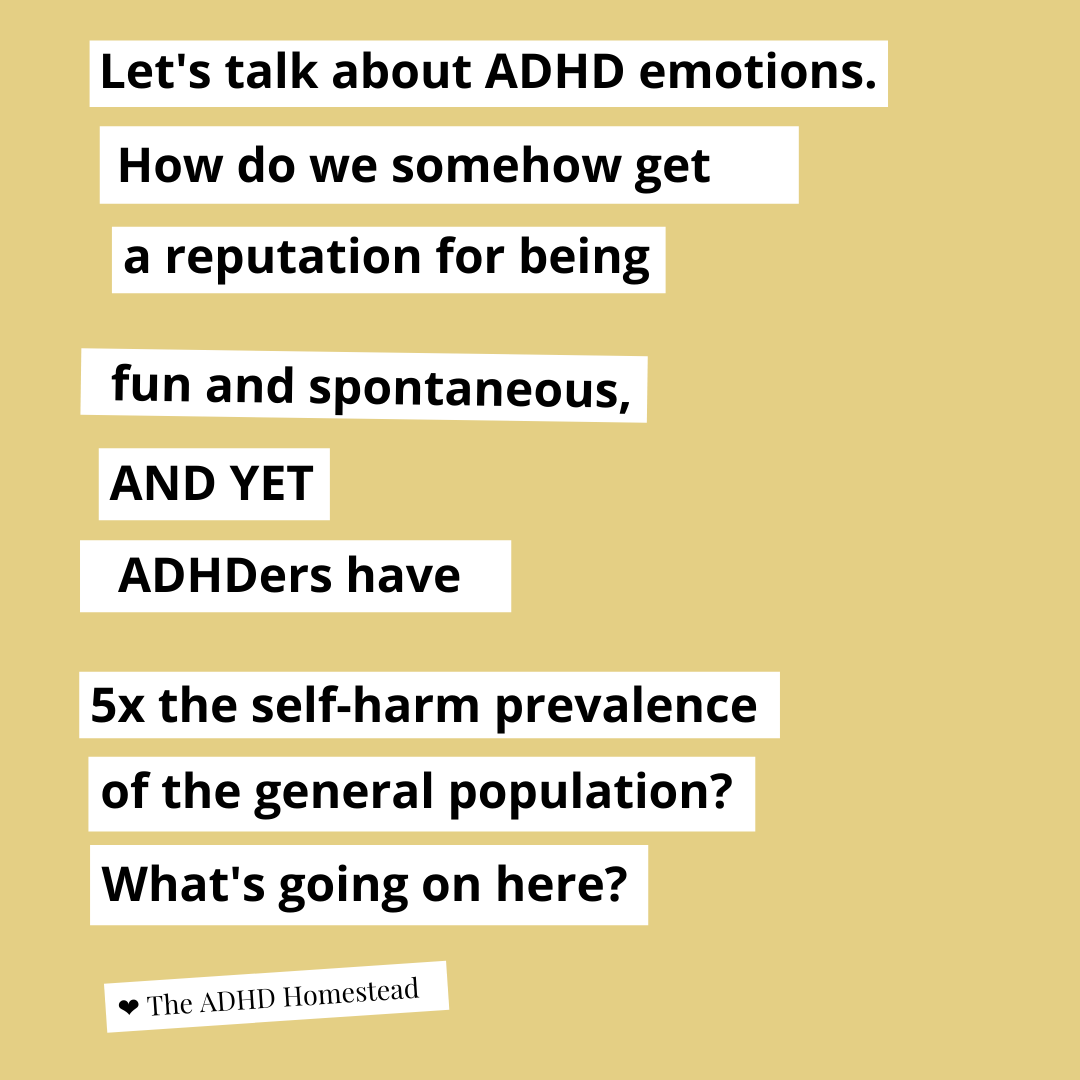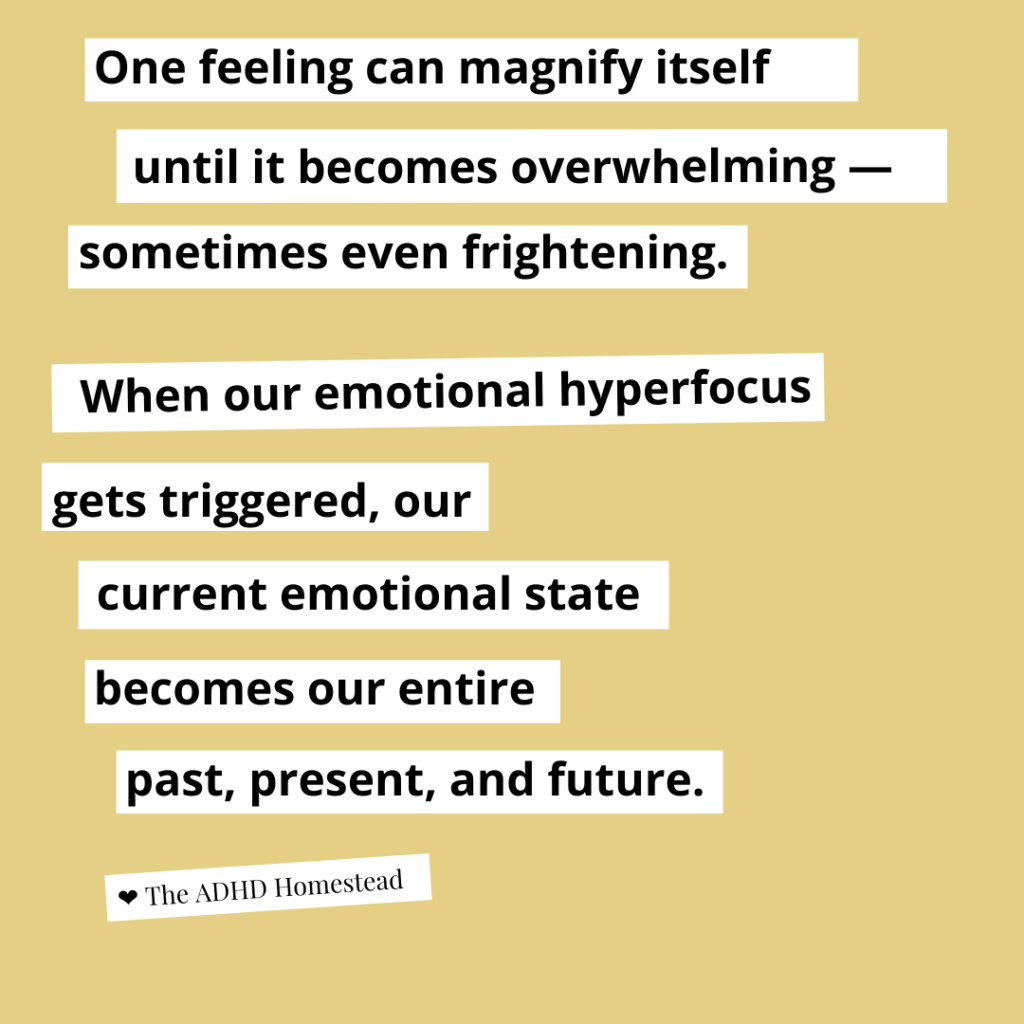Many ADHDers believe we experience emotions more intensely than others do. Our neurotypical counterparts accuse us of being “too sensitive,” “too emotional,” or “dramatic.” They might dismiss us as “making a huge deal over nothing.” It’s almost like they think we have an ulterior motive, or we act this way for effect.
Most of us don’t. Our big feelings are quite real. We don’t manipulate them for our own benefit. In fact, intentional self-harm could be at least five times more prevalent among folks with ADHD.
Others may laugh or roll their eyes and tell us to calm down, but ADHD feelings are serious business. We ignore this literally at our own peril.
What causes ADHD’s big emotions?
Our relationship to our emotions goes back to time blindness. ADHD expert Dr. Russell Barkley tells us our ADHD “disrupts the fabric of time.” Our brains perceive everything as either Now or Not Now. For many of us, the Now crowds out everything else. The Not Now feels far away and abstract.
This explains how we can achieve a hyperfocused, “in the zone” state when doing something rewarding or enjoyable. The object of our hyperfocus becomes the only thing that exists.
The same holds true for strong emotions. I call this emotional hyperfocus. Sometimes people find this charming. When we’re happy, we’re all the way happy. Our brains leave no space for anything that would burst our bubble.
But ADHDers can get stuck on a negative emotion as easily as a positive one. The feeling will magnify itself until it becomes overwhelming, even frightening. Just like time and responsibilities disappear with task hyperfocus, the spectrum of our emotions disappears with emotional hyperfocus. We sink further down the spiral into a state of self-loathing, hopelessness, anger, or worthlessness.
We need an emotional rescue remedy
In the depths of emotional hyperfocus, we easily forget our value and lose our place in the world. While others may think it’s obvious they still love us after a minor disagreement, it’s not at all obvious to us. We can become convinced our families, friends, and the world in general would be better off without us.
That’s a lot to put on our loved ones every time our rejection sensitivity or emotional hyperfocus get triggered. It’s also too much for us to bear on a regular basis, especially if we lack someone supportive and understanding by our side to help us weather the storm. We need a rescue remedy.
To break the spell, imagine your boring future self
In my book Order from Chaos, I recommend a visualization exercise to help break out of ADHD hyperfocus: close your eyes and imagine yourself in a totally mundane moment sometime in the future. Though I mostly talk about task hyperfocus in the book, I give a prime example of how this visualization technique can also interrupt emotional hyperfocus. I’ll excerpt it here:
Following a disagreement with my husband, I found myself unable to let go. It was late. He wanted to go to bed. The disagreement wasn’t a big deal, but [to me] it felt unresolved. My emotions spiraled out of control until I’d lost all perspective. I knew imposing my emotional state on my husband would only stir up drama, so I left the room to calm down by myself.
Except I didn’t calm down. I convinced myself my family would be better off without me and I would never contribute anything of value to the world. I cried uncontrollably and felt terribly alone. Desperate for a lifeline, I closed my eyes and pictured myself in the middle of my kitchen. It was a normal weekend afternoon. I was cooking food for family and friends, surrounded by people whose company I enjoyed. I tried to place myself there in as much detail as possible.
As my brain grabbed onto that scene, I felt like a fog was lifting. The rest of the world, and my life at large, reappeared and felt real once again.
Source: Jaclyn Paul, Order from Chaos: The Everyday Grind of Staying Organized with Adult ADHD
Why this works
Our brains have different regions for thinking about ourselves and about other people. Have you ever kept doing “one more thing” on a fun project even though you know you’ll regret putting off other responsibilities? We think about that regretful future self in the abstract, with the brain regions dedicated to thinking about other people. We literally perceive the self that exists outside this moment as another person. Someone in the Not Now.
This is true for all human brains. However, ADHD’s time blindness and trouble with Now vs. Not Now intensify the effect for us.
Applying this to feelings and relationships, when we make a mistake or experience rejection, that becomes all we see. The self who is valued and loved doesn’t even feel like us. The mistake or the rejection expands to fill our entire self-perception. It becomes the only thing that matters — or will ever matter.
When we imagine a moment in the future, even something as simple as a trip to the grocery store, we forge a stronger connection to our future self. The exercise places us in a different context. Our future self feels a little more like our present self1. We begin to reconnect to ourselves outside this moment.
“Forget it” and “drop it” don’t really work with ADHD
This is the sort of process that may happen automatically for most neurotypical people. Sometimes, when others have an easier time putting setbacks in perspective and maintaining confidence in their inherent self-worth, they expect it to be second-nature for the rest of us too. They see us spiraling out of control and tell us to just “drop it” or “forget it.”
While this feedback can be well-meaning, it doesn’t feel that way. It has an effect similar to other oversimplified, neurotypical advice, like “make a list,” “leave enough time to arrive a few minutes early,” or “just buckle down and do it.” We know what we need to do. Knowing is not the problem.
The problem is knowing how to make it happen. Self-regulation skills don’t come so naturally to us. We need concrete, intentional strategies to manage our lives. This is every bit as true for managing our feelings as for managing our to-do lists.
Many people assume ADHD starts and ends with distractibility and difficulty getting things done. This is a mistake. Treatment and coping strategies extend far beyond our performance at work or school, or our ability to pay bills and arrive to social functions on time. A fivefold self-harm risk should give us pause. We need to talk about ADHD emotions, honor them, and learn how to live with them. Someday, our lives may depend on it.
Footnotes:
1: I originally discovered research around this concept in the book The Willpower Instinct (disclosure: affiliate link) by Kelly McGonigal. It’s a really engaging book, and McGonigal provides an interesting perspective on the science of willpower. Not on topic for this post, but relevant to every ADHDer!
Hey there! Are you enjoying The ADHD Homestead?
Here's the thing: I don't like ads. I don't want to sell your attention to an advertising service run by the world's biggest data mining company. I also value my integrity and my readers' trust above all, which means I accept very few sponsorships/partnerships.
So I'm asking for your support directly. For the cost of one cup of coffee, you can help keep this site unbiased and ad-free.
Below you will find two buttons. The first lets you join our crew of Patreon pals and pledge monthly support for my work. Patrons also have access to my Audioblogs podcast. The second takes you to a simple donation page to pledge one-time or recurring support for The ADHD Homestead, no frills, no strings. Do whichever feels best for you!



